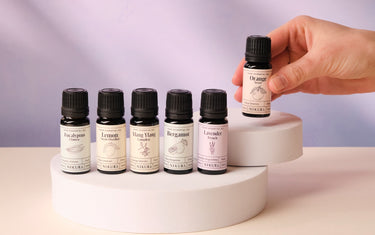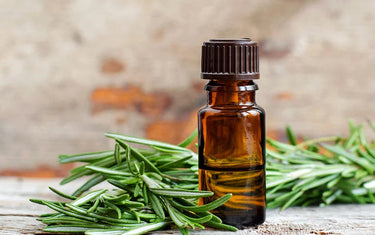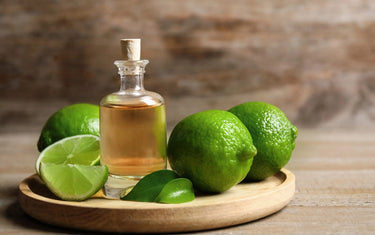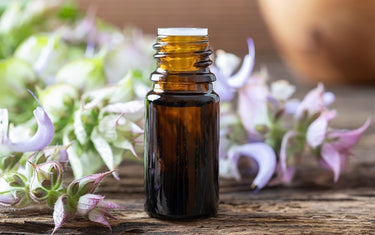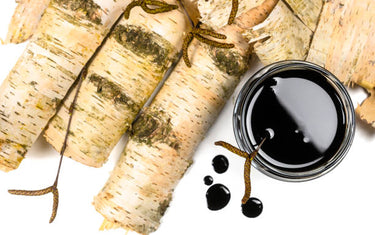7 min read / 23 September 2023 / yasmin sharp
How to Dilute Peppermint Oil
Learn the essential steps to safely dilute peppermint oil.
Share this post

Along with the likes of lavender and lemon, peppermint essential oil remains one of the most popular among fans of aromatherapy.
But given its strength, it’s important to know how to dilute peppermint oil properly, to ensure any allergy and toxicity risks are minimised as much as possible.
Whether you are a first-timer and are unsure about the best way to use it or are a long-time user wanting to make sure you are maximising its effectiveness, we explain all you need to know about dilution, the best carrier oils to use and the main risks to be aware of.
Why do you need to dilute peppermint oil?Peppermint oil is one of the strongest essential oils you can use, due to it containing several volatile oils such as menthol, menthone, cineol and pulegone. This means it should always be diluted before being applied topically, otherwise it could irritate the skin and cause an allergic reaction. In more serious cases, if the oil is not diluted properly, it could cause respiratory issues in people who are particularly sensitive, although this is very rare. |

What is the best way to dilute peppermint oil?
When it comes to diluting peppermint oil and all other types of essential oil, the general rule of thumb for adults is to dilute it to a 2% ratio.
Many people use a teaspoon to measure how many essential oil drops are needed, as it holds approximately 5 ml of oil, which is about 100 drops of carrier oil.
This means to dilute to 2%, you will only need to add 2 drops of peppermint oil to 1 teaspoon of carrier oil, which can be easily done using the dropper.
Of course, if you prefer, you can increase the dilution to 3% (which many people also find just as effective) by adding another drop to the mixture.
What is the best carrier oil to use with peppermint oil?
When looking for a carrier oil to use with peppermint oil, always check that the label states that it is either ‘cold-pressed’ or ‘organic’. This ensures that the oils have undergone minimal processing so they still retain the highest levels of minerals and vitamins that can benefit the skin.
Sheer and light carrier oils are usually best for aromatherapeutic applications. Some of the best oils to use with peppermint oil include:
- Canola Oil
- Corn Oil
- Grapeseed Oil
- Safflower Oil
- Sesame Oil
- Soy Oil
- Sunflower Oil
- Sweet Almond Oil
- Walnut Oil
These oils are light to medium weight, which allows the peppermint oil to quickly absorb into the skin.

Are there any alternatives to carrier oils?
Carrier oils are usually the most common way that peppermint oil is diluted, although there are other options available.
For example, you can add a few drops of the oil of your favourite cream or lotion before applying it to your skin, as they are usually thick enough to avoid irritation.
Alternatively, add a few drops of peppermint to your usual shampoo or conditioner if you want to enjoy some of the benefits peppermint oil can offer your scalp.
What can you use peppermint oil for?
Once you’ve learnt how to dilute peppermint oil for safe application, it’s helpful to know what it can be used for and the possible benefits you could enjoy:
- Treating IBS symptoms: Research has found that abdominal pain and other IBS symptoms can be improved by taking peppermint oil capsules. It may also have an anti-inflammatory effect, relax the smooth muscles of the GI tract and decrease the sensation of pain in the GI tract.
- Reducing feelings of nausea: A 2021 study looked at how peppermint oil could affect nausea and vomiting. Researchers applied one drop of diluted peppermint oil between the upper lip and nose three times a day for 5 days after undergoing chemotherapy. They found that the frequency and severity of vomiting and nausea was reduced.
- Offering pain relief: People involved in a 2019 study discovered that when diluted peppermint oil was applied inside the nose at an angle, it was able to reduce headache pain and frequency. Another study found that people who experienced noncardiac chest pain and had difficulty swallowing saw an improvement in their symptoms after taking peppermint tablets.
- Improving skin and hair health: Researchers found that peppermint oil (diluted to 3%) helped mice to grow thick, long hair after 4 weeks, showing similar results to those produced by minoxidil (Rogaine). In another study[GS7] , researchers discovered that when applied topically, menthol was able to increase skin blood flow.
How to dilute peppermint oil for skin
To dilute peppermint oil for skin, use the step-by-step guide below:
- Make sure you have the peppermint oil and carrier oil to hand.
- You’ll also need a bowl to mix your oils together.
- Pour 10ml of carrier oil into your bowl.
- Add 5 drops of peppermint essential oil and mix well.
If you have completed a patch test or have used peppermint oil before and are confident it is suitable for your skin, you can use the oil on your skin. For larger batches of oil, simply follow the same ratio guideline. For example, if you add 100ml of carrier oil, be sure to mix in 50 drops of peppermint oil.

Is peppermint oil safe for children?
Peppermint oil is safe for children to use, although the dilution ratio should be much lower. A safe dilution level for children is between 0.5% and 2.5%, depending on their age.
For children aged 2 to 6 years old, the recommended dilution level is 1%. This increases to 1.5% for children aged 5 to 15 years old, and for those aged 16 and older, 2% to 2.5% is usually fine.
If you want to give the oil to anyone who is ill, frail or elderly, you may want to use a dilution ratio of 1%.
Is peppermint oil safe to use during pregnancy?
Medical experts advise that pregnant people should not use peppermint oil. This is because there is currently not enough information to say whether it is safe or not. You should speak with your doctor about using peppermint oil during your pregnancy, as they can make an assessment based on your individual circumstances.
However, you can use peppermint oil after you have given birth and are breastfeeding. The oil can pass through into the mother’s milk, which may not be to the baby’s liking, so if they become reluctant to feed, stop using the oil for a few days and see if it correlates with your baby’s feeding behaviour.
Do I need to dilute peppermint oil for diffusion?
When you are diffusing peppermint oil or any other type of essential oil into the air, it does not need to be diluted.
This is because some diffuser models require the oil to be added to water and never involve the use of a carrier oil. To be sure, always read the instructions that come with your diffuser, as each brand and model tend to have their own preferred methods.
You can also add peppermint essential oil to a warm bath without diluting, although you will need to dilute with a carrier oil first.

How to do a patch test for peppermint oil
Some people are more sensitive to peppermint oil than others, so the safest way to check before applying to a large area of skin is to complete a patch test.
- Use half a teaspoon of carrier oil and combine with 1 drop of peppermint oil.
- Apply to the inside of your elbow.
- Cover with a plaster for 24 hours.
- If you do not see any inflammation, itchiness or any other kind of irritation, the oil should be safe to use.
Wash the oil off your skin as quickly as possible if you do start to experience any of the symptoms above.
Also, if you have a nut allergy, avoid using carrier oils that are derived from nuts, such as almond oil, argan oil and apricot kernel oil.
Is peppermint oil safe to use around pets?
Due to its high concentration levels, it is a good idea to avoid using peppermint oil around your pets, as it can prove toxic in some circumstances.
Some dog owners believe it is perfectly fine to use on their pet as a flea remedy (although there is no scientific research to back up this claim) or to offer pain relief.
However, there is no certainty about how safe peppermint oil is for dogs, so the best course of action is to not use it in any form. The same also applies to cats and other pets, so it makes sense to use an alternative oil.
If your pets come into contact with peppermint oil, some of the side effects they could experience include:
- Watery, burning eyes
- Lethargy
- Skin irritation, redness, inflammation and pain
- Nausea and vomiting
- Liver failure
This advice applies to diffusing peppermint oil around your pets and applying it to their skin – even if it has been diluted. If you are growing peppermint in your garden or around your home, make sure your pets are kept away from it, especially those who tend to nibble on things they shouldn’t.

Children, adults and sick and elderly people all require different dilution levels when using peppermint oil, all of which can be done quite easily by using a teaspoon to measure the carrier oil. Pregnant people should avoid using peppermint until their baby is delivered and the oil is also not suitable for children aged less than 2 years old. Dilution is needed when you are applying topically, otherwise, you can diffuse without using a carrier oil or even add it to a bath to let your skin soak in the health benefits.

